Published online at Louisville, Kentucky USA -
An independent, secular, contemporary journal of political and environmental issues dedicated to peaceful reduction of human impacts on Earth. All rights reserved.
Member Planet Love Cooperative © 2016
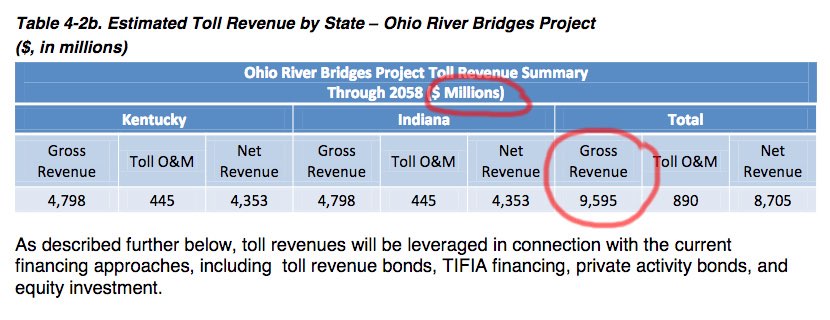
Published online at Louisville, Kentucky USA -
An independent, secular, contemporary journal of political and environmental issues dedicated to peaceful reduction of human impacts on Earth. All rights reserved.
Member Planet Love Cooperative © 2016
BadwaterJournal.com
WHAT UNSUSTAINABLE URBAN GROWTH LOOKS LIKE

6,863 Jefferson County homeowners have no car available
22,978 Jefferson County renters have no car available
2013 State of Metropolitan Housing
“The workforce of employees 16 and older in Jefferson County is
estimated to be 338,215; of these workers,
• 228,795 (68 percent) live in owner-occupied households
• 109,420 (32 percent) are from renter-occupied households
In the Louisville MSA counties outside Jefferson County, nearly all of the workforce drive alone to get to their jobs. Of workers who live in owned homes, 87 percent drive alone to work as compared to 80 percent of the workers who live in rental housing units.
Of the workforce in Jefferson County, approximately 9,795 use public transportation (excluding taxicabs) as a means to get to their jobs;
69 percent of these are from renter-occupied households and 31
percent are from owner-occupied housing units; this stresses the
need for affordable rental housing to be located along transit routes.
There are more renters who walk to work (3,795 out of 5,859) and
about 500 more workers from rental housing that get to their jobs by either a taxicab, motorcycle, bicycle, or other means than workers from owned housing (2,714 and 2,210 respectively). However, for the 3 percent of the total workforce who work at home, 80 percent do so from households which are owner-occupied (U.S. Census Bureau, 2010-2012 American Community Survey). See Chart 16.”
Toll Policy Agreement Concerning
The Louisville-Southern Indiana Ohio River Bridges Project
7.2 Reciprocal Toll Enforcement
The Parties agree to use their powers shared pursuant to the Interlocal to enforce tolls
charged on the LSIORB Project and to assist the TSP and other third party vendors in enforcing tolls charged on the LSIORB Project, as more fully described in the Business Rules.
The Parties agree to cause the agency or agencies in their state responsible for vehicle
registration (“DMV”) to accept notification from the TSP of motorists with vehicles registered in their state with outstanding tolls and fees. The Parties further agree to cause their respective DMVs, upon receipt of such notice, to withhold vehicle registration renewal until payment in full of all outstanding tolls and fees is received by the TSP.
To contribute to the successful collection of tolls on the LSIORB Project, the Parties
agree to enforce tolls charged on any other facilities in either state in the same manner each Party would enforce a toll violation on its own toll facility.
The Parties agree to pursue similar reciprocal toll enforcement agreements with other
states to further contribute to the successful collection of tolls on the LSIORB Project.
7.3 Enhanced Enforcement
The Parties agree to periodically accept from the TSP a list of persistent or chronic
violators residing in their respective state, as indicated in the Business Rules, and to
cooperatively pursue revenue from those individuals to the fullest extent permitted under their respective state’s laws, including civil suits for debt collection, prosecutions in state courts, instructions or requests to state police departments to stop and detain these individuals, and other available collection remedies and enforcement actions.

Users will pay $ 11.3 billion for the
$ 2.3 billion Louisville Bridges Project

December 21, 2016 by Bud Hixson
Ignoring for the minute that scientists tell us we have to phase out combustion of fossil fuels in both power and transportation sectors because global warming is taking the planet towards a catastrophic warming scenario--forget all that. If you don’t care about the end of the world from global warming, you might still care about transferring billions of dollars from the pockets of low and middle income working stiffs to the vaults of the titans of finance. Thats what you bought on credit with the Louisville Bridges Project.
More than creating a cross river linkage for the first time in the East county to boost River Ridge and its mega big box industrial concerns, the Bridges Project established a long term debt obligation to be paid with interest over 37 years. Recent reports by the Bridges toll revenue forecasting company, Steer Davies Gleave, forecasts toll collections continuing to 2054 on the bridges with a total anticipated revenue of $ 11.3 billion dollars. Why do our state tolling agreements authorize collection of $ 11.3 billion dollars for a project trumpeted by the media to cost just $ 2.3 billion?
Annual operations and maintenance costs forecast to 2068 come to $ 1.9 billion dollars with the Downtown Crossing costs running twice the East End crossing costs according to the 2015 Annual Update to the Financial Plan page 48. So it will cost almost as much to operate and maintain the project as to build it in the first place. That still leaves about $ 7.1 billion that will be collected for reasons other than building, maintaining and operating. Interest on borrowed money is what most of that will go to.
NEPA the National Environmental Policy Act, forced the banking financiers and their mega project contractors to conduct a public consultation process in which the cost and various options were discussed. But the media, television, radio, and the states have continued to refer to the Louisville Bridges Project as costing
$ 2.3 billion. Wrong. Drivers and taxpayers will pay $ 11.3 billion or more for the megaproject before the dealing is done.
https://www.flickr.com/photos/downtowncrossing/albums/72157672880239884
Indiana Senator Todd Young with Metro Louisville Mayor Greg Fischer
http://kyinbridges.com/library/
2016 Traffic and Revenue Study • Steer Davies Gleave • June 25, 2016
http://kyinbridges.com/wp-content/uploads/2015-Annual-Update_final_111815.pdf
Ohio River Bridges Project Financial Plan – 2015 Annual Update
Below: Steer Davies Gleave 2016 Traffic and Revenue Study Table 5
After decades-long wait, East End bridge opens
“The bridge and its associated roadways and tunnel cost $1.1 billion, and will require motorists to pay tolls starting Dec. 30.
Because the east crossing that was viewed as one of the most contentious and expensive transportation projects in the region, the sense of relief at its near completion was palpable at Sunday's ceremony. Jeffersonville Mayor Mike Moore took to the podium before official remarks began, cracked a "tall boy" can of Budweiser beer, and took a drink.
"We did it," he said, smiling.”
http://kyinbridges.com/downtown-crossing/news-events/
Construction of the East End Crossing commenced in June 2013. The East End Crossing is part of the $2.3 billion Louisville-Southern Indiana Ohio River Bridges Project, which also includes the construction of the Lincoln Bridge.
Major downtown work on Ohio River Bridges Project complete
Katie Bauer WAVE3
“City and state leaders from both sides of the river made it a point to join the Kentucky Transportation Cabinet and Walsh Construction as they marked a milestone - a billion-dollar project that’s on budget and ahead of schedule - Friday.
“On behalf of every driver who has been stuck in Spaghetti Junction or who inadvertently found themselves in Indiana, hallelujah!” Kentucky’s Lt. Governor Jenean Hampton said.
It's a project that was once set to cost more than $4 billion. City and state leaders worked with both state transportation departments to cut the price and timeline in half.”
http://www.wave3.com/story/33748399/major-work-on-ohio-river-bridges-project-complete
So, are we paying premium prices for fancy bridges and paying the tolling authority for the effort of collecting our money ? Yes.
Are we financing the campaigns of politicians who trip over each other to cut ribbons in front of a fossil fuel boondoggle? Yes.
Did we induce fossil fuel combustion vehicle use to increase from 33.5 million vehicles annually to 54 million annually between 2020 and 2054? Yes.
Did major auto manufacturer and Louisville employer FORD Motor Company exert its political clout to cause Louisville decision makers to choose single operator vehicle transportation mode over low emissions light rail projects ? Yes! But none of the so-called responsible news outlets in Louisville could report the evolution and impacts of the Louisville Bridges Project accurately or impartially. They were boosters for the megaproject from the start.
below: 2015 Financial Plan Update
Amid smoggy days in London, growing calls to clean up Europe’s toxic air
“Here and in cities across environmentally minded Europe, NO2 levels are substantially higher than in North America, or even in Asian and African megacities whose names have become bywords for dirty air. And that is all because of decades of government incentives designed to spur the purchase of supposedly cleaner diesel cars and trucks.
“It’s a complete policy failure,” said Gary Fuller, who directs an air-quality-study center at King’s College London. “No one could defend this.”
Rather than try, European mayors are declaring war on diesel, hoping to give their cities a clean start.
The meaning of “Open for Business”– Louisville will buy anything-
college buildings, stadiums, parking garages, megaprojects
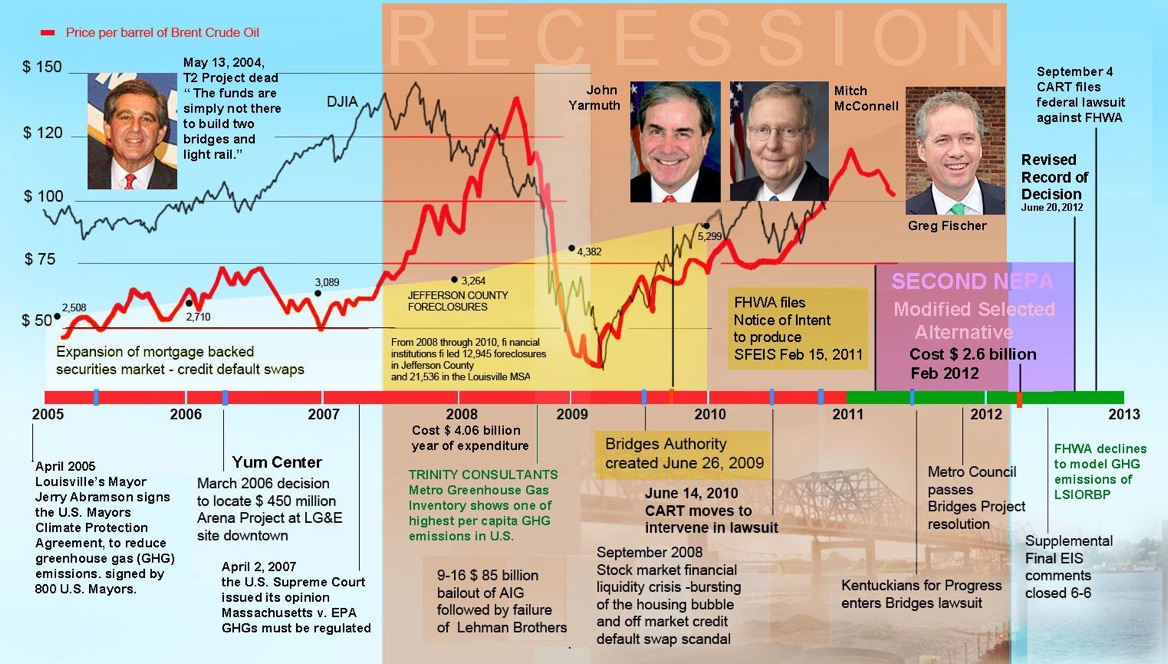
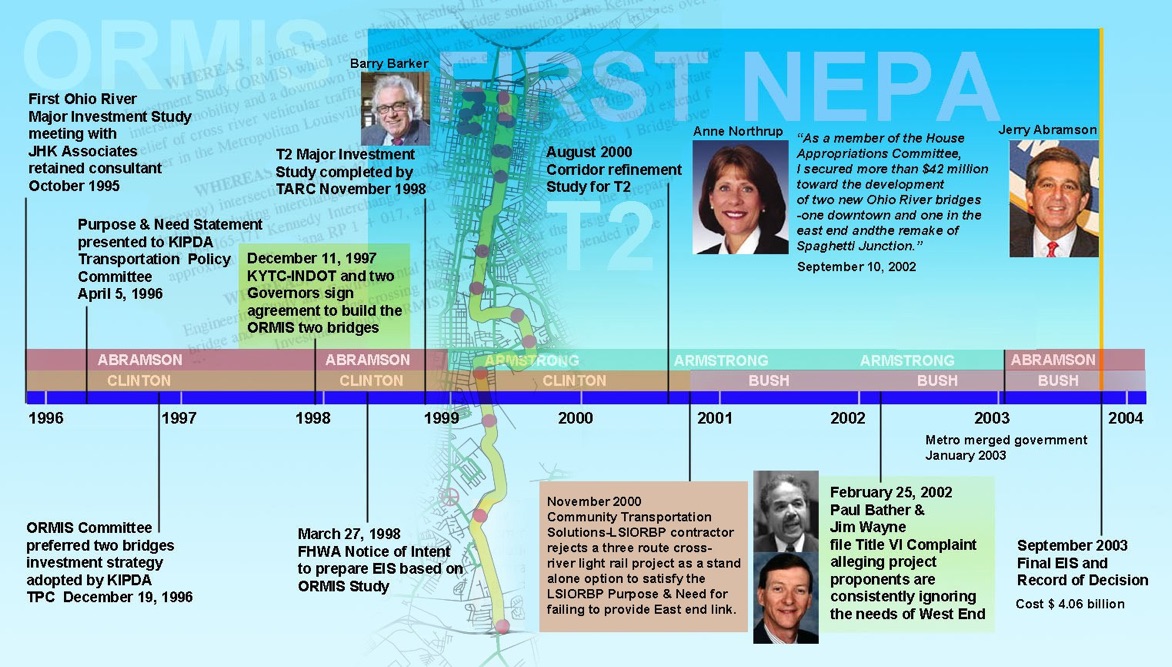
Buried in the past- Louisville’s study of low emissions light rail alternative -killed by the auto manufacturing cartel
Anne Northrup played a major role in killing T2-
see letter below
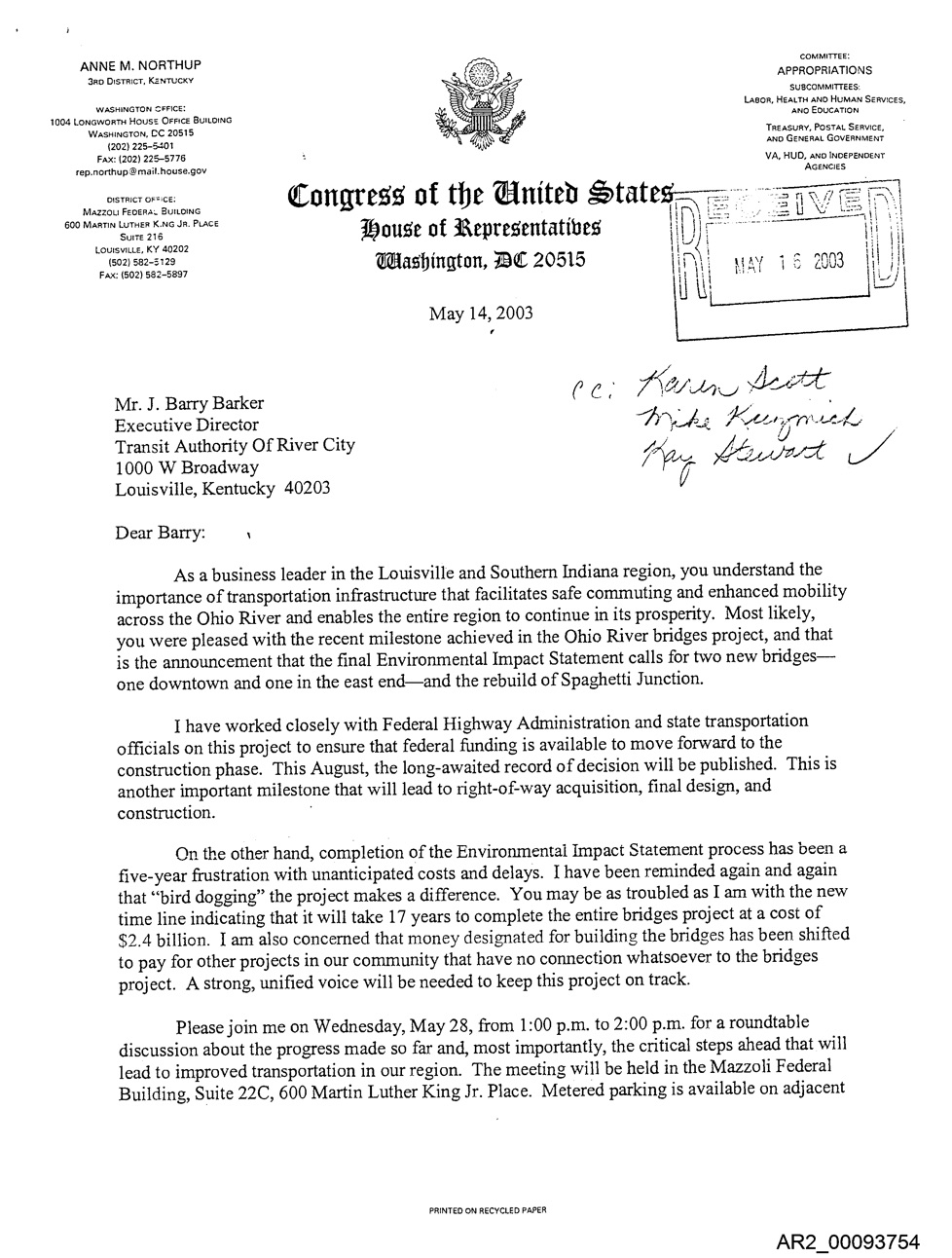
“President-elect Donald J. Trump has made the privatization of public works a centerpiece of his strategy to rebuild America’s airports, bridges, tunnels and roads. Members of his inner circle have sketched out a vision, including billions of dollars of tax credits for private investors willing to tackle big infrastructure projects. And Mr. Trump himself promised in his victory speech “to rebuild our infrastructure, which will become, by the way, second to none.”
42,614,000 billed crossings in 2030 with an anticipated toll revenue of $ 161,315,000.
Thats an average charge of $ 3.79 per crossing.
in 2017, 260 working days X $ 2.00 = $ 520 per year for a commuter paying $ 1.00 each way.
Tolls increase each year by .05 % and will be about $ 1.75 each way at the lowest level in 2030. At $ 3.50 per day thats
$ 910 per year for 5 working days times 52 weeks each year.
By 2030 - 14 years from now - the rapid acceleration of global warming may have caused an increase in temperature of 2.5 degrees centigrade or more above the 20th century average.
The climate change impacts will be significant and will require immediate phase out of fossil fuel combustion vehicles. Automobiles are owned and driven on average 11-14 years. 2017 models will be around til 2030 and are mostly gasoline powered.
Its not likely in the current fossil fuel capitalism that a conversion to full electric cars will occur in the next 14 years. The Bridges Project declined to discuss the forecast fossil fuel traffic counts and related CO2 emissions versus a light rail alternative in the SFEIS.
The Electric Car Market
“It’s still tiny compared with the numbers of cars with traditional combustion engines, and the charging infrastructure remains mixed. The US, China, Norway and Netherlands dominate growth.
Speaking at an event held by Bloomberg earlier this month, BP chief economist Spencer Dale laughed off the threat: “It’s not a game changer over 20 years, even with aggressive electric vehicle penetration,” he said.
Still, it’s a development that last month led analysts at BHP Billiton to brand 2017 as the year when “the electric car revolution really gets started”.
By 2035 they believe 140 million of cars on the road will be electric, about 8% of the global fleet, displacing 2.3 million barrels of oil a day – equal to about 2% of demand.”
8 % electric
cars 2035
“Electric vehicles are potentially disruptive in the medium term, but inevitably there’s a time-lag between EV sales and emissions reductions as petrol and diesel cars sold today will be on the road for the next 15 years,” said PwC director Jonathan Grant, lead author of the LCEI.
See full article HERE
2035
possible 2.5 C average
surface temperature
increase will
trigger emergency
decarbonize
measures
2035 portion
Toll funds may be diverted to light rail construction
with routes on major
traffic
arteries
“Fixed income to investors means perpetual payments by taxpayers and rate-payers for something that should have been public property.”
See the Sheldon Schafer article in the C-J reporting a total average daily toll bridge traffic of 80,000 vehicles.
Wed 1/18 CJ article
80K vehicles travel 3 tolled bridges daily
“Nearly 80,000 vehicles on most weekdays have been streaming across the three tolled bridges over the Ohio River at Louisville, according to the Ohio River Bridges Project. Individually on the five weekdays last week, the Lincoln Bridge had an average daily crossing total of 32,317, the Kennedy had an average of 32,864 daily crossings, while the new Lewis and Clark between Prospect and Southern Indiana saw an average of 14,774 daily crossings. Mindy Peterson, spokeswoman for the Bridges Project, advised that drivers should allow several days for their trips over tolled bridges and transactions to post. And drivers with RiverLink transponders mounted in their vehicles will typically see toll activity post to their accounts within 24-48 hours. If the transaction is being reviewed, it may take several days to post, Peterson said.”
The KYTC Interactive traffic count map from the KYTC web page provides numbers for Sherman Minton and Clark Bridge ADT.
KYTC Interactive crossings count map —see it here http://maps.kytc.ky.gov/photolog/?config=TrafficCounts
shows before the new crossings open 78,534 per day on Sherman Minton and 121,000 per day on I-65 for a total of 199,524 cars per day Add the Clark Bridge at 14,800 for a total of 214,324 for all crossings in 2016. This is a drop from 226,200 in 2010
Altogether the actual Ohio River Crossing Traffic is about 70,000 ADT below what the LSIORB contractor CDM Smith forecast in the 2012 study justifying the approval of two bridges alternative in the Final EIS. The error in prediction is so large as to beg the inference that the contractor provided intentionally misleading data to sell the public on the mega-project. The graph at left is adapted from the CDM Smith 2012 Bridges Traffic Forecast.
Does anyone in Louisville really care if Metro bought $ 4 billion more in bridges than we needed?
February 21, 2017 by Bud Hixson
Toll revenue reports from January and February 2017 yielded hard numbers for daily crossing on three tolled bridges in Metro Louisville. “ The Lincoln Bridge had an average daily crossing total of 32,317, the Kennedy had an average of 32,864 daily crossings, while the new Lewis and Clark between Prospect and Southern Indiana saw an average of 14,774 daily crossings.” Those add up to average daily crossings of 79,955 vehicles. Using KYTC daily average crossings for the I-64 Sherman Minton bridge (82,000) and the Second Street Clark Bridge (20,000) when added give an average total of 181,955 crossings per day for 2017. But in 2012, when the Environmental Impact Statement was being reviewed and approved , the contractor CDM Smith forecast 2017 average daily crossings in the range of 250,000. The difference, 68,000 vehicle per day, is more than the two new downtown bridges are presently carrying.
Did Metro government burden the public with paying for an unnecessary bridge?
CART shared this graph with Metro Louisville Forward and asked if they would confirm or deny the calculation of bridge daily traffic. Jeff O’Brien, AICP, Deputy Director, Office of Advanced Planning for Develop Louisville, of Metro Louisville’s agency, LOUISVILLE FORWARD responded to our inquiry this way:
“KYTC and the LSIORB have been responsible for counting the traffic on the Lincoln, Kennedy, and Lewis and Clark bridges. Metro has not conducted any separate counts. Traffic counts should be requested through those organizations.”
CART asked Louisville Forward to request the current traffic counts and then discuss any disparity between the CDM Smith 2012 forecasts that local leaders relied upon in their decision to build two new bridges. Current data suggests that the 2010 base level 226,200 AADT-assuming steady growth in traffic-would not be reached until 2030. Two bridges were unnecessary-a single East End bridge would have served and as a result, some $ 4-5 billion in financing was incurred unnecessarily. Is that great an engineering error of no interest to local leaders?
The Federal Highway Administration approved the traffic study and the EIS and provided millions of federal funds to build the mega-project. Major players in Washington, Mitch McConnell, John Yarmuth, and locally Mayor for Life Abramson and Mayor Greg Fischer piled on to strong-arm the $ 10.5 billion dollar project through Metro Council. Now that the bridges are built and the debt has to be paid–– where is the flood of traffic that was forecast ?
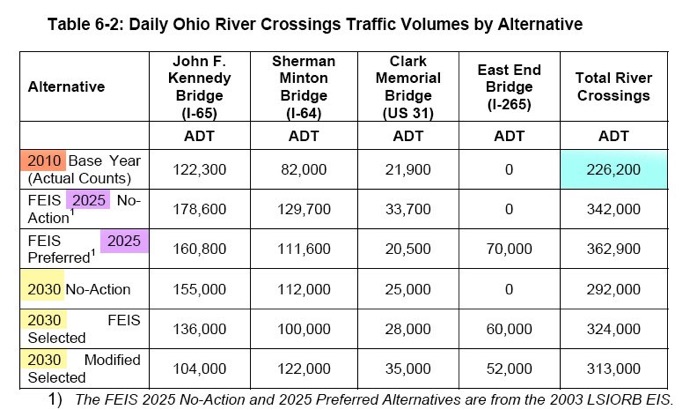




Anne Northrup
Mitch McConnell
Jerry Abramson
Who is minding the store?
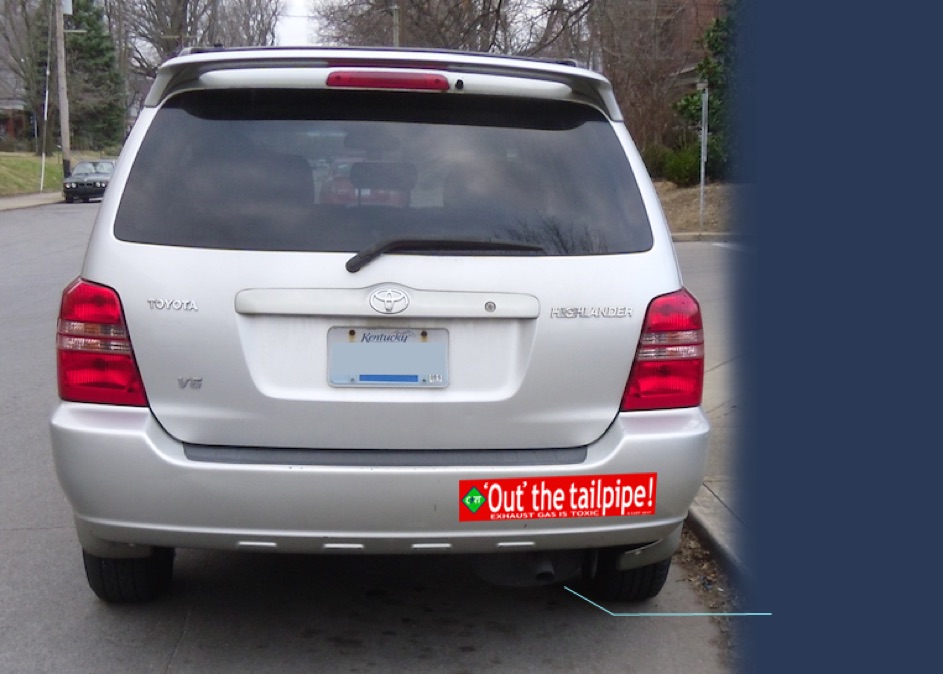
Coalition for Advancement of Regional Transportation seeks membership and partners to
“Out the Tailpipe!”
February 21, 2017 by Bud Hixson
While the Trump administration encourages fossil fuel production by rolling back environmental regulations and killing climate change programs, CART is drawing attention to the individual contribution of all drivers to cumulative carbon emissions. The automakers have begun to design rear bumpers to hide the tailpipe--out of sight -out of mind. In a recent walk through my neighborhood, I found a majority of cars were designed to make the tailpipe disappear. The most critical impact to health and global warming is being “hidden in the closet.” So CART is starting a campaign to “Out the Tailpipe” Join CART and come to the Wednesday meeting March 15 at the Main Branch of the Louisville Free Public Library at 6:30 pm.
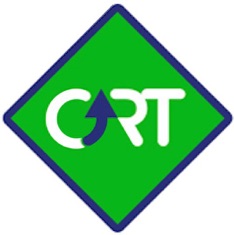

Clin Exp Allergy. 2011 Aug;41(8):1059-71. doi: 10.1111/j.1365-2222.2011.03776.x. Epub 2011 May 30.
Kelly FJ , Fussell JC., Air pollution and airway disease. Clin Exp Allergy. 2011 Aug;41(8):1059-71
Epidemiological and toxicological research continues to support a link between urban air pollution and an increased incidence and/or severity of airway disease. Detrimental effects of ozone (O(3)), nitrogen dioxide (NO(2)) and particulate matter (PM), as well as traffic-related pollution as a whole, on respiratory symptoms and function are well documented. Not only do we have strong epidemiological evidence of a relationship between air pollution and exacerbation of asthma and respiratory morbidity and mortality in patients with chronic obstructive pulmonary disease (COPD), but recent studies, particularly in urban areas, have suggested a role for pollutants in the development of both asthma and COPD.
Some 149 thousand cars per day travel past the airport on I-65 in 2014 according to the KYDOT AADT database. Last accessed August 28, 2015. AADT on the watterson I-264 at Preston was 154,766 cars per day. I-64 at Breckinridge Lane was 69,547 AADT. Eastbound I-71 past the Watterson was 73,526 AADT. I-65 at Spaghetti Junction was 144,000 AADT. Traffic on the
Sherman Minton bridge was 78,534.
KIPDA is forecasting vehicle miles traveled (VMT) in the Metro area to increase from 11,818,000,000 miles per year in 2015 to 14,489,000,000 in 2035– an additional 7.3 million miles per day or 22% increase over 2015 daily VMT of 32,378,082
According to the GHG data reported in the Partnership for a
Green City’s CAP, the transportation sector accounts for approximately 30% of Louisville’s carbon footprint. A significant portion of these transportation emissions results from single occupancy vehicles. Reducing single-occupancy vehicle miles traveled (VMT) requires development and transportation planning that supports multi-modal activity and mass transit.
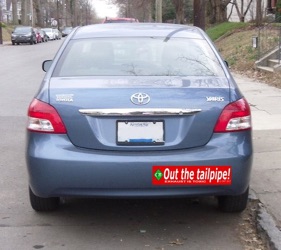
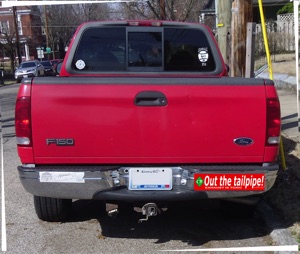
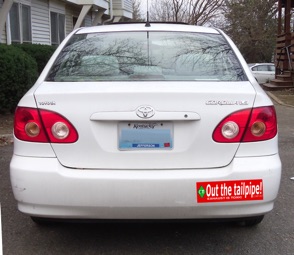
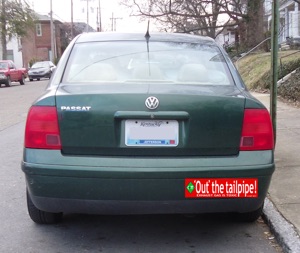
Louisville Metro Government has become an annex of local business. The legislative checks and balances that would normally question major infrastructure projects and evaluate expenditures are non-existent. As the contractors and their banking financiers bring forward even more debt funded mega projects–a new stadium, major sewer infrastructure–no Metro Council person has the guts to challenge the money men and bring transparent analysis– before the Council commits residents to paying billions of tolls, occupational and sales taxes over decades.
Because we built two highway bridges when we only needed one, bridge commuters will pay more money for a longer time. The average working person did not take part in the LSIORBP Environmental Impact Statement process. The average bridge user did not understand the failure to accurately forecast AADT or the merits of alternatives--like a light rail system. People rely on Metro Council representatives to protect them from unnecessary government tax and spend. But the Metro Council failed the people of Louisville– and will do so again.
Angie Schmitt got it wrong— its an $ 11.3 billion dollar Bridges Project
With Louisville’s Gargantuan New Interchange Comes a Profound Loss
"Last week, Louisville cut the ribbon on the $2.6 billion “Ohio River Bridges Project” — a highway expansion that includes a gargantuan new interchange between downtown and the riverfront, known as Spaghetti Junction.
The project was immediately held up as an example of outdated transportation thinking. Not only was the interchange outrageously expensive, it has marred an enormous swath of downtown and severed access to the waterfront for at least another generation.
The project wiped out 30 storefronts — get those taxpaying businesses out of the way — in disadvantaged neighborhoods, Vox reports. Construction also consumed 33 acres of forest around the region, according to the Courier Journal, an area twice the size of Central Park. But to “soften” the “hard edges” of the enormous structure, the paper reported, some 580 trees will be planted around it. (How green!)
It’s all the more upsetting when you consider what might have been. A grassroots proposal to tear down a portion of the old highway and replace it with a park garnered considerable support, but was ultimately dismissed by local elected officials. Here’s a rendering of the park and esplanade that the teardown would have made possible."
David Roberts got it wrong too its an $ 11.3 billion dollar Bridges Project
Louisville’s “Spaghetti Junction” is a testament to how cars degrade cities
Doubling down on auto infrastructure, Kentucky-style.
Updated by David Roberts@drvoxdavid@vox.com Jan 5, 2017, 8:40am EST
http://www.vox.com/science-and-health/2017/1/5/14143746/louisville-spaghetti-junction
Originally the project was going to be gargantuan, with a six-lane freeway through the East End, at a cost of $4.1 billion. In 2011, Indiana and Kentucky agreed to scale back to $2.6 billion. Some of the widening and expansion of freeways was ditched. But the project still included an expansion of Spaghetti Junction. Construction began in 2014.
Read this New York Times story for a capsule history of the divisive project, and urbanist Aaron Renn’s blog post for why it has been, like most giant freeway projects, a huge boondoggle that will cost more and carry fewer drivers than projected.
Vehicle exhaust kills and sickens thousands
Last Week former EPA Director Christine Todd Whitman said traffic air pollution kills 3 times as many people as
fatal car collisions and injuries —or about about 91,000 people per year versus 30,000 from crashes.
http://www.wbur.org/hereandnow/2017/01/31/christine-todd-whitman-epa-trump
"It took work, there was always pushback, but if you look at what the impact is for human health — when you consider that for the most recent year for which we have the full data, which is 2013, 91,000 people in this country died because of dirty, airborne related diseases.
That's almost three times as many people as died on the road that year. This is an issue. This is a serious problem for human health, and you don't want to stop pursuing the healthiest course."
MIT ups the annual death figures--
http://news.mit.edu/2013/study-air-pollution-causes-200000-early-deaths-each-year-in-the-us-0829
Study: Air pollution causes 200,000 early deaths each year in the U.S.
"New MIT study finds vehicle emissions are the biggest contributor to these premature deaths."
Jennifer Chu, MIT News Office August 29, 2013
The epidemic of old people and Cognitive Impairment caused by Traffic emissions
14.9 % of the U.S. population is 65 or over according to the U.S. Census bureau. Thats 48,146,000 people or 48.1 million people over 65 out of a total U.S. population of 323,127,513.
The articles below indicate 15% of the over 65 population will have either mild cognitive impairment -MCI or full blown Alzheimers —that works out to 7.2 million people who will suffer air pollution disease
Now the role of ultrafine particulates from traffic emissions is being shown —UFP enters the brain through the lungs nasel passages
and is carried through the blood to the deep centers of the brain where it affects the hippocampus causing inflammation and neural damage.
TRAFFIC EMISSIONS CAUSE 7.2 million people to suffer cognitive impairment in the U.S.
Cognitive Impairment from fossil fuel combustion
Older women who live in places with high air pollution levels are 92 percent more likely to develop dementia, including Alzheimer’s, according to a new study by scientists at the University of Southern California. The risk is heightened even more in women with the APOE4 gene, a genetic variation associated with an increased chance of developing Alzheimer’s. It is the latest in a growing number of studies linking air pollution with dementia.
The 11-year study looked at health data for 3,647 U.S. women aged 65 to 79 living in 48 states, as well as laboratory experiments on the impact of particulate matter on female mice brains. The scientists found that in mice exposed to air pollution, particulate matter accumulated and damaged neurons in the hippocampus, the part of the brain responsible for memory. They also found that older women who live in areas where pollution levels exceed U.S. EPA standards — most often from power plants and car exhaust — are 81 percent more at risk to experience cognitive decline. The new study examined only women and female mice. Researchers said future studies will include both sexes.
“Microscopic particles generated by fossil fuels get into our body directly through the nose into the brain,” USC scientist Caleb Finch, an expert on aging and co-author of the study, said in a statement. “Cells in the brain treat these particles as invaders and react with inflammatory responses, which over the course of time, appear to exacerbate and promote Alzheimer’s disease.”
See the NEW STUDY HERE
http://www.nature.com/tp/journal/v7/n1/full/tp2016280a.html
Citation: Translational Psychiatry (2017) 7, e1022; doi:10.1038/tp.2016.280
Published online 31 January 2017
Particulate air pollutants, APOE alleles and their contributions to cognitive impairment in older women and to amyloidogenesis in experimental models
Residing in places with fine PM exceeding EPA standards increased the risks for global cognitive
decline and all-cause dementia respectively by 81 and 92%, with stronger adverse effects in APOE ε4/4 carriers.
Ambient fine particles (PM2.5: particulate matter (PM) with aerodynamic diameters<2.5 μm) from traffic emissions are a major source of urban air pollution, accounting globally for 25% of ambient PM2.5.4 Epidemiologic evidence associates cognitive deficits with PM2.5 exposure among the elderly.5 Rodent models also show long-term neurotoxic effects of air pollutants, including memory impairment6 and selective atrophy of CA1 hippocampal neurons observed in pre-clinical AD;7 decreased glutamate receptor subunit GluR1;8 and increased endogenous soluble Aβ.9, 10, 11 However, we lack prospective studies of PM exposure on ADRD risk and interaction with APOE alleles.
Vehicle exhaust and Alzheimer’s disease
https://www.census.gov/quickfacts/table/PST045216/00
2016 ALZHEIMER’S DISEASE FACTS AND FIGURES
https://www.alz.org/documents_custom/2016-facts-and-figures.pdf
The accumulation of the protein beta-amyloid (called
beta-amyloid plaques) outside neurons and the
accumulation of an abnormal form of the protein tau
(called tau tangles) inside neurons are two of several
brain changes believed to contribute to the damage and
destruction of neurons that result in memory loss and
other symptoms of Alzheimer’s. As brain changes
advance, information transfer at synapses begins to fail,
the number of synapses declines, and neurons
eventually die. The accumulation of beta-amyloid is
believed to interfere with the neuron-to-neuron
communication at synapses and to contribute to cell
death. Tau tangles block the transport of nutrients and
other essential molecules inside neurons and are also
believed to contribute to cell death. The brains of
people with advanced Alzheimer’s disease show
inflammation, dramatic shrinkage from cell loss, and
widespread debris from dead and dying neurons
Approximately 15 percent to 20 percent of people age 65 or older
have Mild Cognitive Impairment.
22
People with MCI, especially MCI involving memory problems, are more likely to develop Alzheimer’s and other dementias than people without MCI.
23-24
A recent systematic review of 32 studies found that an average of 32 percent of individuals with MCI developed Alzheimer’s disease in 5 years.
http://newsroom.ucla.edu/releases/ucla-study-reports-how-air-pollution-42993
Study shows how ultrafine particles in air pollution may cause heart disease
"It appears that the smallest air pollutant particles, which are the most abundant in an urban environment, are the most toxic," said first author Dr. Jesus Araujo, assistant professor of medicine and director of environmental cardiology at the David Geffen School of Medicine at UCLA. "This is the first study that demonstrates the ability of nano-sized air pollutants to promote atherosclerosis in an animal model."
Researchers found that mice exposed to ultrafine particles exhibited 55 percent greater atherosclerotic-plaque development than animals breathing filtered air and 25 percent greater plaque development than mice exposed to fine-sized particles.
“Out the Tailpipe!”

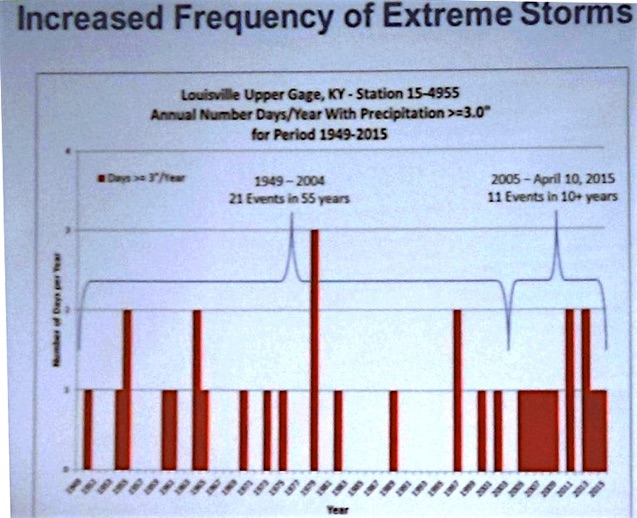


Climate Change and heavy debt burden behind MSD’s $ 8 billion dollar 20 Year Facility Plan
Louisville, KY February 28, 2017 by Bud Hixson
MSD Director Tony Parrot conducted a “Community Conversation” last night at the Douglas Community Center near Big Rock in Cherokee Park. He rolled out a request for public support and political approval for a bucket full of MSD capital infrastructure projects. Parrot argued that our sewer, drainage and flood protection infrastructure is old and getting older and major repair and replacement projects are required NOW.
MSD’s infrastructure planning team therefore proposes an encyclopedic array of capital projects to be built over 20 years and altogether costing $ 4.3 billion dollars. Director Parrot omitted that another $ 4 billion or more in debt interest on borrowed funds will be required. Thus the commitment of MSD rate payers that he seeks will be for $ 8 billion dollars to be repaid in MSD monthly bills until 2066 or beyond-over about 50 years.
Obviously when hundreds of multi-million dollar projects are placed before the public and Metro Council in one Omnibus spending proposal—nobody—not Councilman Brandon Coan who was present–not any of the attendees from the local neighborhood–had read the 500 pages or so of project materials. The merits of any individual project are out of focus and ultimately at the sole discretion of MSD– the public is simply asked to approve the $ 8 billion price tag. And was not told by MSD the total cost was $ 8 billion.
MSD’s proposed Mega Project is not formally proceeding under the National Environmental Policy Act NEPA laws—like the LSIORBP did—no one has sued to demand a full Environmental Impact Statement be prepared on the $ 4.3 billion capital construction proposal that will use substantial federal funding. They should.
Instead we are being given MSD’s chaotic and self serving ‘home cooked’ documents in what one attendee described as a 'document dump.’ Document dumps are a tactic used in litigation to swamp a weaker legal team with an overwhelming pile of documents. The result is inability to form a coherent response to a multi-faceted problem. MSD includes the endorsement of the ‘Wet Weather’ citizens consultation team– a collection of political insiders masquerading as disinterested neighbors that seem to always unanimously endorse whatever plan MSD trots out.
Ironically, Director Parrot continued the practice of other Metro infrastructure employees, like those in Louisville Forward, of not using the ‘Climate Change’ term if he could avoid it. He said MSD’s practice was to refer to ‘increased frequency of extreme storm events.” MSD is too coy.

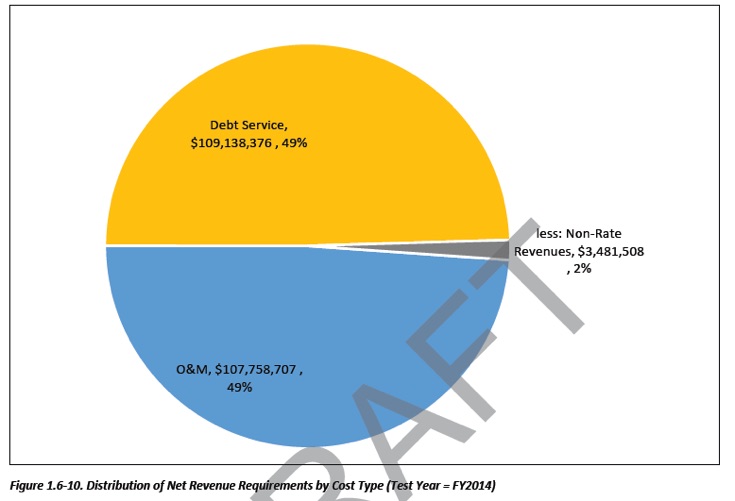
http://www.louisvillemsd.org/CriticalRepairPlan
Critical Repair & Reinvestment Plan
"The difficult truth is the solutions come with a price tag of $4.3 billion over the next 20 years, including almost $500 million to finish the remaining Consent Decree projects to meet the federal order to reduce sewer overflows."
"To implement a $4.3 billion capital program and the associated costs to operate new facilities, MSD must have the funding to pay for it."
20-Year Comprehensive Facility Plan | Plan Overview pge 20
"While 6.9 percent per year rate increases do provide enough revenue to implement the entire Facility Plan CIP over the 20-year planning period, the recommended schedule cannot be achieved, and completing critical public safety projects could be deferred by 3 to 5 years.
Completing the projects in the recommended CIP on the schedule recommended in the Facility Plan will require a 20-percent to 25-percent rate increase in FY2018 ($10.50 to $13.12 per month for a typical customer in FY2018), followed by rate increases up to 6.9 percent for the remaining years of the planning period.
"Neglecting this essential system is no longer an option—serious failures are occurring at an increasingly rapid pace. The ability to successfully apply temporary repairs rather than permanent fixes diminishes significantly with each passing day. Rainfall totals that once could be managed by the system now overwhelm it. This risk is heightened by the increased frequency of extreme storm events. The back-to-back storm events experienced in 2015 flooded homes, leaving families without shelter. Cars were washed away, streets were impassable, schools and businesses shut down, and public safety was threatened in proportions not seen in decades. Citizens demanded that measures be taken to prevent similar occurrences from happening again."
Below: South Fork of
Beargrass Creek on
February 22, 2017.
Fossil fuel combustion is causing a global catastrophic warming that has been dubbed ‘the Anthropocene era.’ Local corporate citizens too big to criticize and keep your job are pumping tons of carbon dioxide into the global atmosphere. MSD is not convincing as a scientific and engineering leader when local politics muzzles the Director from leading on this issue. One wonders how deeply this Mega Sewer Project grab is another get rich scheme for wealthy investors. But MSD seems to FEAR that major storm events are coming to Louisville that cannot be avoided and will cause millions of dollars of damage and risk public health and security. Be clear about it.
This FEAR combined with a crushing load of debt including a $ 76 million loss in some securities investments referred to in the financial disclosures is forcing MSD to make a big grab now. I asked Parrot to confirm that 52 cents of every revenue dollar is going to pay interest and debt burden. 48 cents actually keeps the lights on and treats wastewater.
MSD doesn’t have $ 4.3 billion dollars and without an agreement with the public and Metro Council to let MSD rates rise by $ 10 dollars per month, MSD won’t have the borrowing capacity to fund the MEGA SEWER PROJECT thats two times as big as the LSIORBP capital costs. We will be paying $ 10.5 billion for the bridges to 2054 and beyond, and if this MEGA PROJECT is approved, rate payers will shell out some $ 8 billion to 2066 and beyond. See the Mountain of Debt graphic below. Director Parrot also stated that the Morris Forman plant is becoming outdated and under capacity and needs another $ 1 billion in expansion and upgrades to service our wastewater treatment needs. Thats in addition to the $ 4.3 billion Facilities Plan.
The prospect is that MSD is right. No center of competent analysis or political dissent exists in Louisville that will be able to turn aside the economic development juggernaut of a $ 4.3 billion jobs and spending proposal.
Without any supporting text, Parrot claimed that one dollar in MSD infrastructure spending returns $ 2.62 to the community. But, who gets the $ 2.62? Financiers and bankers who float interest bearing bonds? Wealthy investors already filthy rich who park their millions in tax exempt interest paying public debt? The people who will pay $ 8 billion til 2066 will be the general MSD rate payer.
The general public in Louisville is without protection against bankers, high rolling lawyers, engineers, contractors and their political gamblers who slap the ‘jobs’ label on Mega-project chicanery.

© 2016
© 2017


WHY is It called BadwaterJournal ?
This blog originally focused on water pollution caused by sewer overflows. See some related pages HERE and HERE
I used the simple language ‘bad water’ to dispense with the hyper-technical terms that scientists use to describe the characteristics of bad water, such as ‘total dissolved solids’ or ‘fecal coliform colonies per mili-liter’. The intent was to inform with photographs taken along the streams in Jefferson County Kentucky USA about the problems of sewer overflows caused by unchecked development and undercapacity infrastructure. Typical residents needed to know more about the local streams where children wade.
comments to:
Bud Hixson,
Badwater Journal
mail to:
1336 Hepburn Avenue
Louisville, KY 40204
Some pages have been put in storage
if you click on a link that doesn’t work
and you want to see the page
contact me at budhix@iglou.com

Children in bacteria laden
waters at Big Rock in
Cherokee Park
Louisville, KY



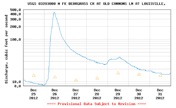
‘Infraculture’ © 1990 Bud Hixson



See Last months issue
of BadwaterJournal HERE
See, DYING of CARS, HERE


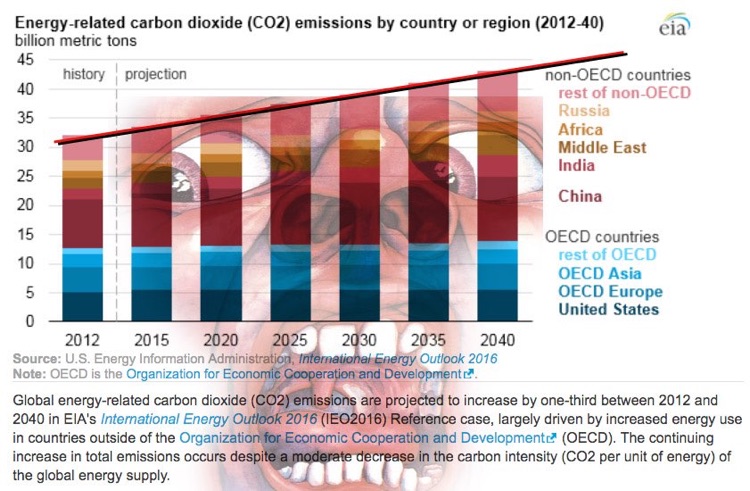
Graph source NASA: http://earthobservatory.nasa.gov/Features/GlobalWarming/images/ipcc_scenarios.png
World Temperature Could Rise 1.5°C by 2020
Global warming could occur more quickly than expected, according to modeling published in PLoS One (www.tinyurl.com/jm6bbx8).
The model, developed by Prof Ben Hankamer of The University of Queensland’s Institute for Molecular Bioscience and Dr Liam Wagner of Griffith University, forecasts that population and economic growth combined with rising energy use per person could significantly increase global energy demand and CO2 emissions, causing world average temperatures to rise by 1.5°C as early as 2020.
OFF BY 20 YEARS
ACTUAL v. MODELED Emissions
and corresponding global ambient surface
temperature rise show HIGH SIDE BREAKOUT
Models are not capturing all the greenhouse gas emissions including methane release and temperature rise is coming higher -sooner than computer modeled.
“The year-to-date temperature across global land and ocean surfaces was 1.75°F above the 20th century average of 57.4°F. This was the highest for January–October in the 1880–2016 record, surpassing the previous record set in 2015 by 0.18°F.
The year-to-date globally averaged land surface temperature was 2.66°F above the 20th century average. This was the highest for January–October in the 1880–2016 record, exceeding the previous record of 2015 by 0.34°F.”
NOAA.GOV State of the Climate Report
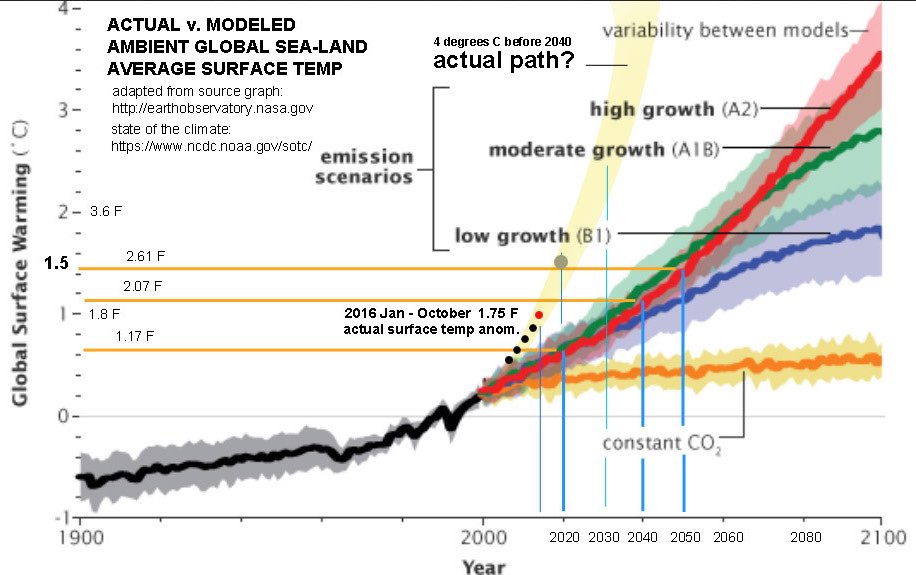
World Bank “Turn Down the Heat”
“The consequences for development would be severe as crop yields decline, water resources change, diseases move into new ranges, and sea levels rise. Ending poverty, increasing global prosperity and reducing global inequality, already difficult, will be much harder with 2°C warming, but at 4°C there is serious doubt whether these goals can be achieved at all.”
“Many of the worst projected climate impacts outlined in this latest report could still be avoided by holding warming below 2°C. But, this will require substantial technological, economic, institutional and
behavioral change. It will require leadership at every level of society.”
“Today the scientific evidence is overwhelming, and it’s clear that we cannot continue down the current path of unchecked, growing emissions.”

“Commercial industrial barrens - the shoals of commerce, where exhausted survivors of the credit card debt system wash up beneath garish stalked lures to exchange debt for greasy food, greasy sex, and just plain grease, gas and oil. The rivers run with salt and petroleum, the air with particulate and ozone, the peoples faces are streaked with soot, their mouths parted with labored breath. On the expressway of destiny, riding beasts of chrome and iron, humanity took an early exit to nowhere.”

